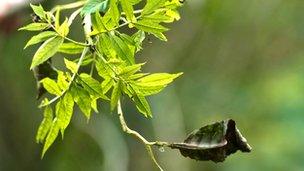Ash fungus genetic code unravelled
- Published

UK scientists have unravelled the genetic code of the ash dieback fungus.
The DNA "blueprint" contains clues to how the pathogen attacks ash trees and possibly, in the long term, how to stop the epidemic, say genetic researchers.
The data has been released on the web to enable international experts to study the problem of dieback, which is attacking forests across Europe.
Chalara fraxinea has the potential to devastate the UK's population of 80 million ash trees.
Scientists are trying to find out how it spreads, why it is so deadly to most trees, and whether any ash trees are naturally resistant to the fungus.
A team at The Sainsbury Laboratory (TSL) and the John Innes Centre in Norwich sequenced the RNA of an infected ash twig in December.
They have now cracked the DNA sequence of three samples of the fungus in a matter of weeks.
The data is being published on the crowd sourcing website OpenAshDieBack in a £2.4m project funded by the Biotechnology and Biological Sciences Research Council.
Prof Sophien Kamoun of TSL says the full genome sequence - the DNA instructions to "make" the fungus - gives clues to how ash trees succumb to the infection.
"There are toxin genes that we discovered," he told BBC News.
"That's possibly a lead for how the fungus kills the tree. And we also found additional genes that could be contributing to the virulence of the fungus, that are worth studying."
He said further research should reveal how the ash dieback fungus has spread around the world, and how it compares with other, more benign, strains.
"We're learning more about the biology of the fungus and also how it compares to other fungi," said Prof Kamoun.
The long term goal is to map the genes that give a minority of ash trees resistance to the pathogen.
A type of ash tree in Denmark, known as Tree 35, - which makes up 2% of the Danish ash tree population - has managed to survive the epidemic.
Computer models will also be developed to look at the distribution and spread of the fungus, and how it might progress.
Professor Allan Downie of the John Innes Centre said: "Ash and Chalara genomics have never before been studied in the level of data we are doing."
Mysterious organism
In a collaborative effort, Scottish researchers are studying samples of ash dieback fungus from France, to see how they compare with samples from British woodlands.
The goal is to look at 30 samples of fungus from across the UK and mainland Europe.
A scientist involved in decoding the genetic code of the ash dieback fungus shows a sample
Dr Mark Blaxter of the school of biological sciences at the University of Edinburgh said: "We have already used our advanced DNA technology to turn the fungus from being a very mysterious organism into something where we know the complete DNA code, in a matter of weeks.
"All the information we gather is being made public on the internet as soon as we can, so that people anywhere can join with us in tackling ash dieback.
"This 'crowd sourcing' is a new way of doing research that we hope will be a model for the future."
Rapid spread
Ash dieback was first recorded in Eastern Europe in 1992, spreading over two decades to infect most of the continent.
The first confirmed case in the UK was in March 2012, and since then dieback has been confirmed at 391 sites, including 170 in established woodlands.
Forests in Norfolk, Suffolk, Kent and Essex are among the worst affected, and the disease has now spread to woodland and nurseries in England, Wales, Scotland and Northern Ireland, according to the Forestry Commission.
The first three cases of ash dieback in 2013 have been found in Wales, the Forestry Commission recently confirmed.
- Published14 December 2012
- Published4 March 2013